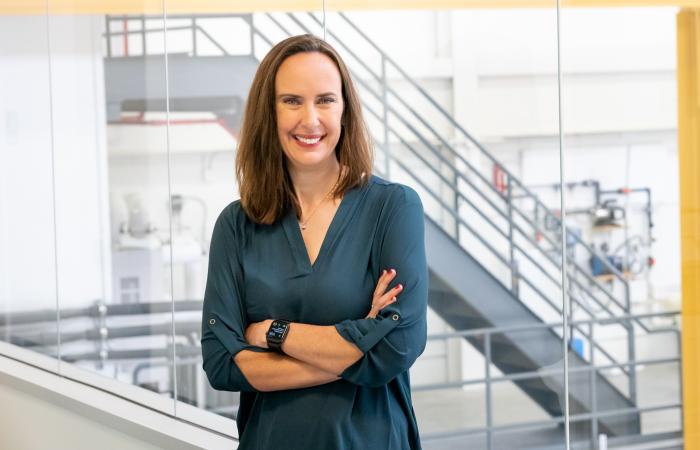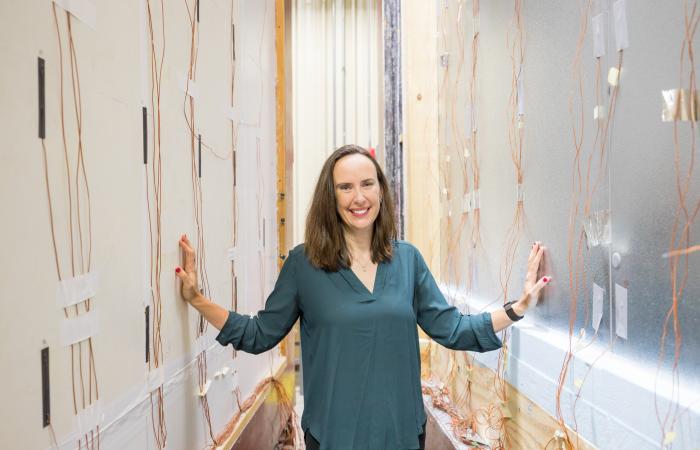-

ORNL's Christine Walker, a technical consultant and researcher in the Integrated Building Performance Group, works with the nation's federally owned buildings through the Federal Energy Management Program, helping to reduce their carbon footprint and improve their energy performance. Credit: ORNL/U.S. Dept. of Energy
-

As a researcher with ORNL's building technologies program, Christine Walker analyzes the energy efficiency of buildings, studying their roofs, walls and materials to better understand the impacts on performance. Credit: ORNL/U.S. Dept. of Energy
-

ORNL's Christine Walker, a technical consultant and researcher in the Integrated Building Performance Group, works with the nation's federally owned buildings through the Federal Energy Management Program, helping to reduce their carbon footprint and improve their energy performance. Credit: ORNL/U.S. Dept. of Energy
-

As a researcher with ORNL's building technologies program, Christine Walker analyzes the energy efficiency of buildings, studying their roofs, walls and materials to better understand the impacts on performance. Credit: ORNL/U.S. Dept. of Energy
She may not wear a white coat or carry a stethoscope, but Christine Walker of Oak Ridge National Laboratory spends her days diagnosing the energy health of buildings and figuring out how to improve their efficiency to achieve cost savings and reduce their carbon footprint.
As a researcher in the Integrated Building Performance Group at ORNL and the program manager for the Department of Energy's Federal Energy Management Program, or FEMP, Walker has her finger on the pulse of the nation's federal buildings. In a sense, she's the "building doctor," helping to improve the performance or health of facilities and buildings across the United States.
"FEMP's mission is to help agencies address their energy efficiency goals, and we do that by providing technical assistance and supporting them (while) implementing improvements to meet executive orders," she said.
Training for impact
Walker's task behind the scenes is to ensure federal agencies realize and maintain energy savings performance contracts, or ESPCs.
She joined ORNL in 2019 as a technical consultant in the buildings program after more than 20 years spent working with industry and academia. She was promoted to FEMP program management early on. She said it's a sizeable task, considering there are more than 400 diverse federal agencies in the U.S., representing agriculture, commerce, defense and transportation sectors, as well as programs within DOE. These agencies consist of more than 350,000 energy-utilizing buildings, making the federal government one of the largest energy consumers in the country. Keeping this wide-ranging portfolio on track, Walker said, boils down to training and workforce development.
"Our job is to provide training to agencies and show them how they can meet their energy goals," Walker said. "Every federal agency is responsible for a growing number of buildings, and these buildings are huge energy users with aging infrastructure. How can they reduce their energy consumption? How can they meet decarbonization or renewable energy goals, for example? I help them in figuring it out."
Before developing an energy efficiency plan, Walker and a team of project associates offer agencies a training boot camp. It's typically a week-long onsite instruction, covering not only the project development process, but also details on ESPCs and utility energy service contracts.
"Performance contracts require annual verification of energy savings because agencies use those guaranteed savings to pay for efficiency improvements," she said. "An agency has to verify that they're actually achieving savings so that they can, for example, make the payment on new equipment going forward."
Walker's work with FEMP ensures federal agencies can fulfill their critical missions by becoming efficient, resilient and secure - necessary attributes as the nation transitions to clean energy.
"These agencies lead by example through cutting their energy waste," she said. "I support that effort by providing the information, tools and assistance required to meet and track their energy-related requirements and goals."
Support provided by Walker and her associates might include sharing information about federal laws and requirements that help reduce energy and water use or implementing resilience planning to facilitate the integration of advanced, secure technologies. They also look at managing the challenges presented from cybersecurity threats and how to integrate an ESPC to streamline procurement processes so that energy conservation measures can be installed in federal buildings.
"Often the most impactful assistance we provide is to track measurement and verification activities, proving that savings associated with energy conservation measures have indeed been met," Walker said. "From reviewing investment grade audits, looking at performance contracting finance rates, assisting technical feasibility studies - everything in between - then tying that back into measurement and verification activities, we can solve a lot of issues and get agencies and their respective buildings on a healthy energy efficiency track."
Modeling to scale
Walker is an architect and mechanical engineer with a doctorate in building technology from the Massachusetts Institute of Technology and a Master of Business Administration from Indiana University. She is trained to identify market opportunities in buildings and then turn them into effective business solutions. She also understands the science behind how buildings function - each with a unique rhythm, determined by the airflow and ventilation, equipment and materials that make up the walls, roof and floor.
"I bridge the gap between academia: the theoretical and the practical," she said. "When I completed my dissertation at MIT, I instrumented a fully occupied building, measuring airflow, ventilation effectiveness and taking that theoretical knowledge, collecting the data, really seeing how the airflow patterns impact the thermal performance to apply that to building simulation techniques."
Walker's research in producing reduced-scale building models led her to compare the performance among different types of buildings, continuing to visualize airflow to determine ventilation effectiveness, understand temperature distribution and the impacts of thermal mass. She said it was an opportunity to show how one system impacts another within a building, like observing a living being where one slight tweak or change can have a positive or negative impact.
An eye for detail
It wasn't a small change, but rather a big opportunity combined with a mix of artistic talent and a knack for speaking French that led to Walker's interest in the design and function of buildings. She grew up in the Chicago area where she was encouraged by her engineer father who worked in biofuels to study architecture. As Walker remembers, it wasn't necessarily her first career choice but a logical one.
"I was always good at art, as well as math and physics, so it made sense," she said. "But I really didn't have an appreciation for buildings until I studied abroad."
She studied for a year in France as an undergraduate at the University of Illinois at Champaign-Urbana, completing an internship where she was handed a sketch pad and a pencil and encouraged to spend days observing the building landscape throughout the country.
"We sketched building structures and examined them. It was beautiful," she said. "I also saw the correlation between the church and state buildings within cities. So, you could sort of see almost that battle between the government head versus the church head in some of the older cities, and how that influenced all the various architectural structures."
It was while sitting at Parisian cafes and sketching many churches that she said she saw the bones of the structures.
"The more I would study a building, the more it revealed itself to me," Walker said. "I loved this experience so much that later I went to Egypt to study the pyramids, went through Italy and toured the architecture there, as well."
Over time, she realized she was perfecting an eye for detail, observing trends and anomalies within data, deriving insights into her observations and developing metrics. That strive for perfection has led to Walker working toward completing another degree: a master's in business analytics.
"To do what I do, I have to be able to see the fine print, to visualize what's not immediately evident," she said. "I'm really doing forensics on buildings; where everything matters, and you never stop learning."






